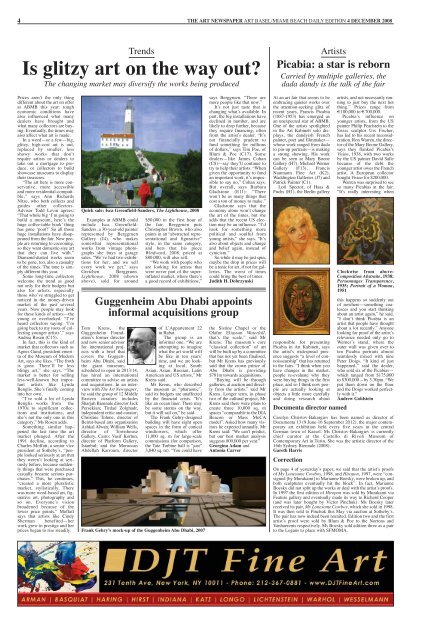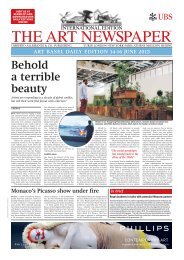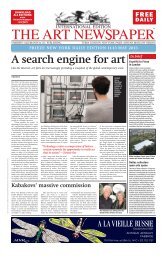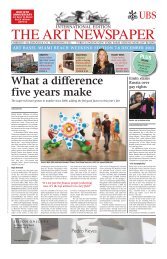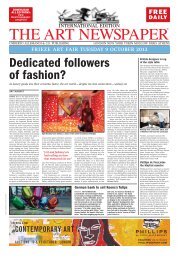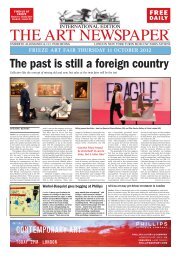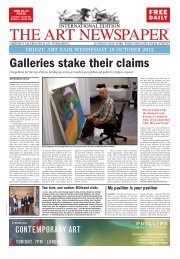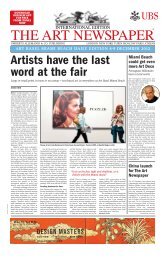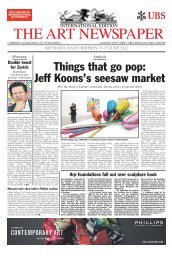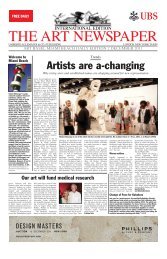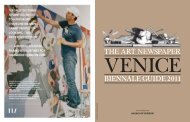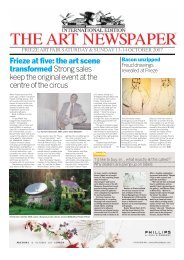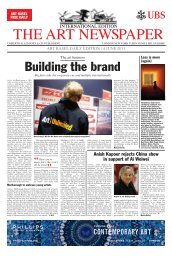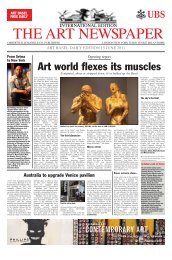Loyal buyers secure a positive start - The Art Newspaper
Loyal buyers secure a positive start - The Art Newspaper
Loyal buyers secure a positive start - The Art Newspaper
You also want an ePaper? Increase the reach of your titles
YUMPU automatically turns print PDFs into web optimized ePapers that Google loves.
4 THE ART NEWSPAPER ART BASEL/MIAMI BEACH DAILY EDITION 4 DECEMBER 2008<br />
Trends<br />
Is glitzy art on the way out?<br />
<strong>The</strong> changing market may diversify the works being produced<br />
Prices aren’t the only thing<br />
different about the art on offer<br />
at ABMB this year: tough<br />
economic conditions have<br />
also influenced what many<br />
dealers have brought and<br />
what many collectors are buying.<br />
Eventually, the times may<br />
also affect what art is made.<br />
In a word—or a few—big,<br />
glitzy, high-cost art is out,<br />
replaced by smaller, less<br />
showy works that don’t<br />
require artists or dealers to<br />
take out a mortgage to produce,<br />
or collectors to build<br />
showcase museums to display<br />
their treasures.<br />
“<strong>The</strong> art here is more conservative,<br />
more accessible<br />
and more residential-compatible,”<br />
says Ann Richards<br />
Nitze, who both collects and<br />
guides other collectors.<br />
Advisor Todd Levin agrees:<br />
“That whole big ‘I’m going to<br />
build a museum, here’s the<br />
huge coffee-table book’ thing<br />
has gone ‘poof!’ So all those<br />
huge installations have disappeared<br />
from the fair. Now people<br />
are returning to cocooning,<br />
so they want domestic-size art<br />
that they can live with.”<br />
Diamond-dusted works seem<br />
to be gone, too, also a casualty<br />
of the times. <strong>The</strong> tone is simply<br />
different this year.<br />
Some long-time collectors<br />
welcome the trend as good<br />
not only for their budgets but<br />
also for artists, especially<br />
those who’ve struggled to get<br />
noticed in the money-driven<br />
market of the past several<br />
years. Now people may look<br />
for these kinds of artists—the<br />
young or overlooked. “I’ve<br />
heard collectors saying: ‘I’m<br />
going back to my roots of collecting<br />
younger artists’,” says<br />
Andrea Rosen (C15).<br />
In fact, this is the kind of<br />
market that collectors such as<br />
Agnes Gund, president emerita<br />
of the Museum of Modern<br />
<strong>Art</strong>, says she likes. “<strong>The</strong> froth<br />
is gone. <strong>The</strong>re’ll be less<br />
blingy art,” she says. “<strong>The</strong><br />
market is better for selling<br />
less-well-known but important<br />
artists like Lynda<br />
Benglis. She’s finally coming<br />
into her own.<br />
“I’ve sold a lot of Lynda<br />
Benglis works from the<br />
1970s to significant collections<br />
and institutions, and<br />
she’s not the only one in this<br />
category,” Ms Rosen adds.<br />
Something similar happened<br />
the last time the art<br />
market plunged. After the<br />
1991 decline, according to<br />
Charles Moffatt, a senior vice<br />
president at Sotheby’s, “people<br />
looked seriously at art that<br />
they weren’t looking at seriously<br />
before, because suddenly<br />
things that were purchased<br />
casually became serious purchases.”<br />
This, he continues,<br />
“created a more pluralistic<br />
market, stylistically. <strong>The</strong>re<br />
was more word-based art, figurative<br />
art, photography and<br />
so on. Everyone’s vision<br />
broadened because of the<br />
lower price points.” Moffatt<br />
says that artists like Cindy<br />
Sherman benefited—her<br />
work grew in prestige and her<br />
prices began to rise steadily.<br />
Quick sale: Isca Greenfield-Sanders, <strong>The</strong> Lighthouse, 2008<br />
Examples at ABMB could<br />
include Isca Greenfield-<br />
Sanders, a 30-year-old painter<br />
represented by Berggruen<br />
Gallery (J4), who makes<br />
somewhat representational<br />
works from vintage photographs<br />
she buys at garage<br />
sales. “We’ve had two exhibitions<br />
for her, and we sell<br />
every work we get,” says<br />
Gretchen Berggruen.<br />
Lighthouse, 2008 (shown<br />
above), sold for around<br />
Tom Krens, the<br />
Guggenheim Foundation’s<br />
former director<br />
and now senior advisor<br />
for international projects<br />
with a brief that<br />
covers the Guggenheim<br />
Abu Dhabi, said<br />
the giant museum,<br />
scheduled to open in 2013/14,<br />
has hired an international<br />
committee to advise on artists<br />
and acquisitions. In an interview<br />
with <strong>The</strong> <strong>Art</strong> <strong>Newspaper</strong>,<br />
he said the group of 12 Middle<br />
Eastern curators includes<br />
Sharjah Biennale director Jack<br />
Persekian; Tirdad Zolghadr,<br />
independent critic and curator;<br />
Christine Tohme, director of<br />
Beirut-based arts organisation<br />
Ashkal Alwan; William Wells,<br />
director of Townhouse<br />
Gallery, Cairo; Vasif Kortun,<br />
director of Platform Gallery,<br />
Istanbul; and the Moroccan<br />
Abdellah Karroum, director<br />
$50,000 in the first hour of<br />
the fair. Berggruen puts<br />
Christopher Brown, who also<br />
paints in an “abstracted representational<br />
and figurative”<br />
style, in the same category,<br />
and bets that his piece<br />
Windward, 2008, priced at<br />
$80,000, will also sell.<br />
“We work with people who<br />
are looking for artists that<br />
were never part of the superinflated<br />
market, where there’s<br />
a good record of exhibitions,”<br />
Guggenheim Abu Dhabi appoints<br />
informal acquisitions group<br />
of L’Appartement 22<br />
in Rabat.<br />
<strong>The</strong> group is an<br />
informal one. “We are<br />
attempting to imagine<br />
what the art world will<br />
be like in ten years’<br />
time, and we are looking<br />
at local, South<br />
Asian, Asian, Russian, Latin<br />
American and US artists,” Mr<br />
Krens said.<br />
Mr Krens, who described<br />
the museum as “pharaonic”,<br />
said its budgets are unaffected<br />
by the financial crisis. “It’s<br />
like an ocean liner. <strong>The</strong>re may<br />
be some storms on the way,<br />
but it will sail on,” he said.<br />
<strong>The</strong> Frank Gehry-designed<br />
building will have eight open<br />
spaces in the form of conical<br />
windtowers, which offer<br />
11,000 sq. m for large-scale<br />
commissions (for comparison,<br />
the Tate Turbine hall is “just”<br />
3,840 sq. m). “You could have<br />
Frank Gehry’s mock-up of the Guggenheim Abu Dhabi, 2007<br />
says Berggruen. “<strong>The</strong>re are<br />
more people like that now.”<br />
It’s not just taste that is<br />
changing what’s available. In<br />
part, the big installations have<br />
declined in number, and are<br />
likely to drop further, because<br />
they require financing, often<br />
from the artist’s dealer. “It’s<br />
not financially prudent to<br />
fund something for millions<br />
of dollars,” says Tim Poe, of<br />
Blum & Poe (C17). Some<br />
dealers—like James Cohan<br />
(C8)—say they’ll continue to<br />
try to help their artists. “When<br />
given the opportunity to fund<br />
an important work, it’s impossible<br />
to say no,” Cohan says.<br />
But overall, says Barbara<br />
Gladstone (E11): “<strong>The</strong>re<br />
won’t be as many things that<br />
cost a ton of money to make.”<br />
Gladstone says that the<br />
economy alone won’t change<br />
the art of the times, but she<br />
adds that the recent US election<br />
may be an influence. “I’d<br />
look for something more<br />
political and soulful from<br />
young artists,” she says. “It’s<br />
also about objects and change<br />
and belief again, instead of<br />
cynicism.”<br />
So while it may be just spin,<br />
maybe the drop in prices will<br />
be a tonic for art, if not for galleries.<br />
<strong>The</strong> worst of times<br />
could bring the best of times.<br />
Judith H. Dobrzynski<br />
the Sistine Chapel or the<br />
Olafur Eliasson Waterfall,<br />
that’s the scale,” said Mr<br />
Krens. <strong>The</strong> museum’s core<br />
“classical collection” of art<br />
will be built up by a committee<br />
that has not yet been finalised,<br />
but Mr Krens has previously<br />
said that the crown prince of<br />
Abu Dhabi is providing<br />
$781m towards acquisitions.<br />
“Buying will be through<br />
galleries, at auction and directly<br />
from the artists,” said Mr<br />
Krens. Longer term, in phase<br />
two of the cultural project, Mr<br />
Krens said there were plans to<br />
create three 10,000 sq. m<br />
spaces “comparable to the DIA<br />
Beacon or Mass MoCA<br />
model”. Asked how many visitors<br />
he expected annually, Mr<br />
Krens said: “We can’t predict,<br />
but our best market analysis<br />
suggests 800,000 per year.”<br />
Georgina Adam and<br />
Antonia Carver<br />
<strong>Art</strong>ists<br />
Picabia: a star is reborn<br />
Carried by multiple galleries, the<br />
dada dandy is the talk of the fair<br />
At an art fair that seems to be<br />
embracing quieter works over<br />
the attention-seeking glitz of<br />
recent years, Francis Picabia<br />
(1887-1953) has emerged as<br />
an unexpected star of ABMB.<br />
One of the artists spotlighted<br />
in the <strong>Art</strong> Kabinett solo displays,<br />
the dandyish French<br />
painter, poet and filmmaker—<br />
whose work ranged from dada<br />
to pin-up portraits—is making<br />
a strong showing. His work<br />
can be seen at Mary Boone<br />
Gallery (H7), Michael Werner<br />
Gallery (F13), Francis<br />
Naumann Fine <strong>Art</strong> (K2),<br />
Waddington Galleries (J7) and<br />
Patrick Painter (C1).<br />
Lori Spector, of Haas &<br />
Fuchs (H1), the Berlin gallery<br />
responsible for presenting<br />
Picabia in <strong>Art</strong> Kabinett, says<br />
the artist’s widespread presence<br />
suggests “a level of connoisseurship”<br />
that has returned<br />
to the fairs. “I think when you<br />
have changes in the market,<br />
people re-evaluate why they<br />
were buying things in the first<br />
place, and so I think now people<br />
are actually looking at<br />
objects a little more carefully<br />
and doing research about<br />
Documenta director named<br />
Correction<br />
artists, and not necessarily running<br />
to just buy the next hot<br />
thing.” Prices range from<br />
€100,000 to €700,000.<br />
Picabia’s influence on<br />
younger artists, from the US<br />
painter Philip Pearlstein to the<br />
Swiss sculptor Urs Fischer,<br />
has led to his recent reconsideration.<br />
Ron Warren, the director<br />
of the Mary Boone Gallery,<br />
says they flanked Picabia’s<br />
Vision, 1938, with two works<br />
by the US painter David Salle<br />
because of the debt the<br />
younger artist owes the French<br />
artist. A European collector<br />
bought Vision for $200,000.<br />
Warren was surprised to see<br />
so many Picabias at the fair.<br />
“It’s really interesting when<br />
Clockwise from above:<br />
Composition Abstraite, 1938;<br />
Personnages Transparence,<br />
1935; Portrait of a Woman,<br />
1951<br />
this happens so suddenly out<br />
of nowhere—something coalesces<br />
and you <strong>start</strong> thinking<br />
about an artist again,” he said.<br />
“I don’t think Picabia is an<br />
artist that people have thought<br />
about a lot recently.” Anyone<br />
looking for proof of the artist’s<br />
relevance needed only go to<br />
Werner’s stand, where the<br />
outer wall was given over to<br />
ten Picabia portraits almost<br />
seamlessly mixed with nine<br />
Peter Doigs. “It kind of just<br />
happened,” said the dealer,<br />
who sold six of the Picabias—<br />
which ranged from $175,000<br />
to $300,000—by 3.30pm. “We<br />
put them down on the floor<br />
and the Doigs worked perfectly<br />
with it.”<br />
Andrew Goldstein<br />
Carolyn Christov-Bakargiev has been named as director of<br />
Documenta 13 (9 June-16 September 2012), the major contemporary<br />
art exhibition held every five years in the central<br />
German town of Kassel. Ms Christov-Bakargiev is currently<br />
chief curator at the Castello di Rivoli Museum of<br />
Contemporary <strong>Art</strong> in Turin. She was the artistic director of the<br />
16th Sydney Biennale (2008).<br />
Gareth Harris<br />
On page 4 of yesterday’s paper, we said that the artist’s proofs<br />
of My Lonesome Cowboy, 1998, and Hiropon, 1997, were “consigned<br />
[by Murakami] to Marianne Boesky, were broken up, and<br />
both sculptures eventually hit the block”. In fact, Marianne<br />
Boesky did not split up the works or deal with the artist’s proofs.<br />
In 1997 the first edition of Hiropon was sold by Murakami via<br />
Feature gallery and eventually made its way to Richard Cooper<br />
(and was later bought by Victor Pinchuk). Ms Boesky later<br />
received its pair, My Lonesome Cowboy, which she sold in 1998.<br />
It was then sold to Pinchuk this May via auction at Sotheby’s.<br />
<strong>The</strong> pair has now indeed been reunited. Edition two and the first<br />
artist’s proof were sold by Blum & Poe to the Nortons and<br />
Vanhaerents respectively. Ms Boesky sold edition three as a pair<br />
to the Logans to place with SFMOMA.


